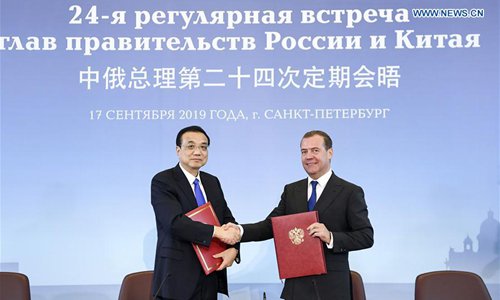After Li’s Russia visit, ties eye new avenues
By Guan Zhaoyu and Zhang Tingting Source:Global Times Published: 2019/9/19 21:58:48

Chinese Premier Li Keqiang and his Russian counterpart Dmitry Medvedev co-chair the 24th regular meeting between Chinese and Russian heads of government in St. Petersburg, Russia, Sept 17, 2019. Photo: Xinhua
Premier Li Keqiang was on an official visit to Russia from Monday to Wednesday. On Tuesday, Li and his Russian counterpart Dmitry Medvedev co-chaired the 24th regular meeting between Chinese and Russian heads of government. Li said in an interview published in a Russian newspaper on Monday that China and Russia will raise bilateral cooperation to a higher level. Li's visit to Russia epitomizes China-Russia relations in the new era, pointing the way to the two countries' future cooperation.
As the international political game goes on, the nature of world trade acquires new dimensions. The most direct example is that in the international industrial chain, the supply chain and the purchasing chain are experiencing a new round of reorganization.
Global trade pattern is undergoing profound changes. As the world's largest consumption market, the second-largest economy and world factory, China acts as an engine of world trade, and has led the cycle of the world's supply chain and purchasing chain. But the US-launched trade war against China has hastened the decoupling between Chinese and US markets and driven the core of the world trade circulation to return to Eurasia.
According to data released by the General Administration of Customs (GAC) on September 8, China's top three trading partners in the first eight months this year were the EU, ASEAN and the US. China's exports to the EU and ASEAN increased 11.8 percent and 15.7 percent, while exports to the US decreased 3.7 percent. China's imports from the EU and ASEAN increased 6.7 percent and 6.9 percent respectively, while those from the US decreased 23.5 percent. Apparently, as the US tries to sever ties with China, ASEAN and the EU have quickly filled in vacuum.
As the largest country in Eurasia, Russia is an economic corridor that links up Eurasia. China and Russia are two major powers that share greatest level of trust, highest level of collaboration and highest strategic value. Bilateral trade cooperation can help Russia integrate into the trade circulation among China, the EU and ASEAN, and thus adds momentum to trade.
Nowadays, the global political pattern is linked with global trade pattern. Thus the political pattern is also undergoing changes and reorganization. China and Russia are two relatively large political bodies, and the change in world political pattern may lead to domestic political changes. The two countries' development requires stable external environment. In recent years, China and Russia have proactively participated in the governance of Eurasia. The two countries have helped prevent and control risks as well as lead cooperation in Eurasian governance. For example, they have successfully mediated heated issues such as the Iranian nuclear issue, the Korean Peninsula nuclear issue and the conflicts between India and Pakistan.
As US isolationism prevails, China and Russia have put the Eurasian region on the track of development and promoted peace in the region by connecting under the China-proposed Belt and Road Initiative and the Russia-led Eurasian Economic Union.
People-to-people exchanges were also an important subject on the agenda of the meeting between Li and Medvedev. In June, China and Russia agreed to upgrade relations to a comprehensive strategic partnership of coordination for a new era. The two countries agreed to regard people-to-people exchanges as one of the priorities of the partnership.
In recent years, bilateral cooperation has been carried out on an equal footing and the two countries have been learning from each other. The US is putting up trade barriers against China and making it harder for Chinese students to study in the US. Against such backdrop, student exchange can be an important area for China-Russia bilateral cooperation in the future.
Through people-to-people exchanges, China and Russia can better understand each other, and Russia can get rid of the "China threat" conspiracy theories. The two countries should deepen people-to-people exchanges to yield opportunities for development.
In the new era, China and Russia will face unprecedented development opportunities as well as fiercer competition. The two countries should cherish political trust and maintain a leading position in the international arena.
Guan Zhaoyu is associate research fellow with Chongyang Institute for Financial Studies, Renmin University of China (RDCY). Zhang Tingting is assistant research fellow with the RDCY. opinion@globaltimes.com.cn
Posted in: VIEWPOINT,CHINA-EUROPE